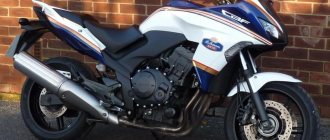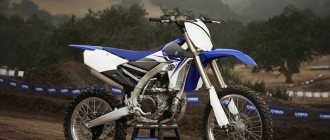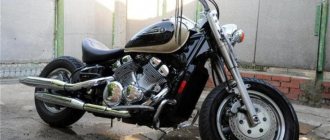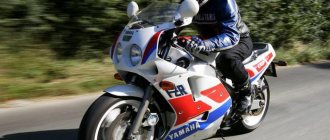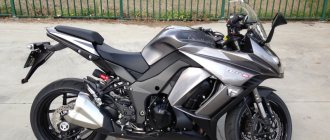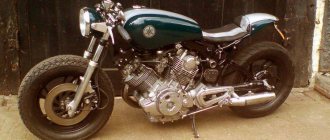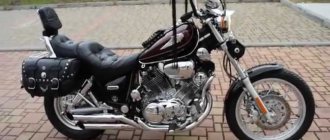Flaws:
- High cost of acquisition and operation.
- The front suspension has a non-standard design, so the behavior of the motorcycle when turning in different directions may be different. In addition, this type of suspension is afraid of direct impacts from the front. Often, after an accident, it is quite difficult to restore a motorcycle, since the frame may be damaged.
- Frequent braking can cause the pads to overheat.
- Not suitable for city driving due to its large dimensions and weight. When driving within the city, it is necessary to adjust the mirror system.
The Yamaha gts 1000 tourer is not widely used due to its high price and operating costs. However, its reliability and technical characteristics have no competitors even now, despite the fact that it was produced 20 years ago. It has a unique design, power, and speed. It is chosen by people who are used to traveling by motorcycle.
Specifications
Comparative table of technical characteristics of the 1st and 2nd generations of Yamaha FZ-1:
| Model | Yamaha FZ1, FZS1000 Fazer (2001-2005) | Yamaha FZ1-N, FZ1-S Fazer (2006-2015) |
| Motorcycle type | naked | |
| Frame | steel | aluminum diagonal |
| engine's type | 4-cylinder, 4-stroke, in-line | |
| Working volume | 998 cm³ | |
| Bore/Stroke | 74.0 x 58.0 mm | 77.0 x 53.6 mm |
| Compression ratio | 11,4:1 | 11,5:1 |
| Cooling | liquid | |
| Number of valves per cylinder | DOHC, 5 valves per cylinder | |
| Fuel supply system | carburetors, 4x Mikuni BSR37 with throttle position sensor (TPS) | injector, 45 mm |
| Ignition type | digital transistor (TCI) | digital transistor (TCI) with 32-bit ECU |
| Maximum power | 143 hp at 10000 rpm | 150 hp at 11000 rpm |
| Maximum torque | 106 Nm at 7500 rpm | 106 Nm at 8000 rpm |
| Clutch | Multi-disc in oil bath, cable drive | |
| Transmission | 6-speed | |
| type of drive | chain | |
| Front tire size | 120/70 ZR17M/C (58W) | |
| Rear tire size | 180/55 ZR17M/C (73W) | 190/50 ZR17M/C (73W) |
| Front brakes | 2 discs, 298 mm, 4-piston calipers | 2 discs, 320 mm, 4-piston calipers (optional ABS) |
| Rear brakes | 1 disc, 267 mm, 2-piston caliper | 1 disc, 245 mm, 1-piston caliper (optional ABS) |
| Front suspension | telescopic fork 43 mm (all adjustments), travel – 140 mm | inverted fork 43 mm (all adjustments), travel – 130 mm |
| Rear suspension | pendulum with monoshock absorber (all adjustments), stroke – 135 mm | pendulum with monoshock absorber (all adjustments), stroke – 130 mm |
| Overall dimensions (LxWxH) | 2125 x 765 x 1190 mm | 2140 x 770 x 1205 mm – FZ1-S 2140 x 770 x 1060 mm – FZ1-N |
| Seat height | 820 mm | 815 mm |
| Wheelbase | 1450 mm | 1460 mm |
| Minimum ground clearance (clearance) | 140 mm | 135 mm |
| Gas tank capacity | 21 l (including reserve – 4 l) | 18 l (including reserve - 3.4 l) |
| Maximum speed | 260 km/h | 246 km/h (N version) |
| Acceleration to 100 km/h | 2,9 | 3.3 sec |
| Motorcycle weight (dry) | 208 kg | 198 kg – FZ1-N 204 kg – FZ1-S |
| Motorcycle weight (curb) | 231 kg | 214 kg – FZ1-N 220 kg – FZ1-S |
Brief history of the model
Model:
Yamaha FZ1 (FZS1000N/NC) USA.
Model:
Yamaha FZS1000 Fazer (Europe).
Model code:
5LV1, 5LV2, 5LV3, 5LV6.
Model:
Yamaha FZ1 (FZS1000P/PC) USA.
Model:
Yamaha FZS1000 Fazer (Europe).
Model code:
5LV8, 5LV9, 5LVA, 5LVD.
Model:
Yamaha FZ1 (FZS1000R/RC/SPR) USA.
Model:
Yamaha FZS1000 Fazer (Europe, South Africa).
Model code:
5LVF, 5LVH, 5LVN, 5LVP, 5LVR, 5LVG, 5LVM, 5LVU.
Model:
Yamaha FZ1 (FZS1S/SC) USA.
Model:
Yamaha FZS1000 Fazer / FZS10S (Europe, South Africa).
Model code:
1C21, 1C23, 1C27, 1C25, 1C26, 1C22, 5LVY.
Model:
Yamaha FZ1 (FZS1T/TC, FZ1T/TC) USA.
Model:
Yamaha FZS1000 Fazer / FZS1000S/T (Europe).
Model code:
1C2B, 1C29, 1C2A, 1C28, 1C2F.
Model:
Yamaha FZ1 (FZS10V/VC) USA.
Model:
Yamaha FZ1-N / FZ1-S Fazer (Europe, Australia).
Model code:
3C38, 3C37, 3C39, 3C32, 3C33, 3C31, 2D12, 2D13, 2D11, 3C36.
Model:
Yamaha FZ1 (FZS10W/WC) USA.
Model:
Yamaha FZ1-N / FZ1-S/SW Fazer (Europe, Australia).
Model code:
3C3C, 3C3B, 3C3A, 2D19, 2D18, 2D17, 2D16, 2D15, 2D14, 5D01, 5D02, 3C3F.
Model:
Yamaha FZ1 (FZS10XCR/XCGY) USA.
Model:
Yamaha FZ1-N / FZ1-S/SX Fazer (Europe, Australia, Japan).
Model code:
3C3K, 2D1G, 2D1D (Australia); 3C3J, 3C3H, 2D1F, 2D1E, 2D1C, 2D1B, 22C4, 22C3, 22C2, 22C1, 5D04, 5D03, 3C3N (Europe); 3C3G, 2D1A (Japan).
Model:
Yamaha FZ1 (FZS10YL/YCL, FZS10YG/YCG) USA.
Model:
Yamaha FZ1-N / FZ1-S/SY Fazer (Europe, Australia, Japan).
Model code:
3C3S, 2D1P, 2D1L (Australia); 3C3R, 3C3P, 2D1N, 2D1M, 2D1K, 2D1J, 22C8, 22C7, 22C6, 22C5, 5D05, 5D06, 3C3V (Europe); 3C3W (Japan).
Model:
Yamaha FZ1 (FZS10ZR/ZCR, FZS10ZB/ZCB) USA.
Model:
Yamaha FZ1-N/NA, FZ1-S/SA Fazer (Europe, Japan).
Model code:
1CA4, 5D09, 5D07, 3C3X, 1CA5, 22CB, 22C9, 1D1U, 2D1R (Europe); 1CA8, 2D1X (Japan).
Model:
Yamaha FZ1 (FZS10AS/ACS) USA.
Model:
Yamaha FZ1-N/NA, FZ1-S/SA Fazer (Europe, Japan).
Model code:
1CAE, 5D0D, 5D0B, 1CAF, 1CA9, 22CD, 1EC1 (Europe);
1CAJ (Japan).
Model:
Yamaha FZ1 (FZS10BW/BCW) USA.
Model:
Yamaha FZ1-N/NA, FZ1-S/SA Fazer (Europe, Japan).
Model code:
1CAS, 5D0F, 1CAK, 22CF, 1EC4 (Europe); 1CAU, 1CAT, 1EC8, 1EC7 (Japan).
Model:
Yamaha FZ1 (FZS10D/DC) USA.
Model:
Yamaha FZ1-S Fazer (Europe, Japan).
Model code:
1CAY (Europe); 2DV2 (Japan).
Model:
Yamaha FZ1 (FZS10EW/ECW, FZS10E/EC) USA.
Model:
Yamaha FZ1 (FZS10FGY/FCGY) USA.
Frame numbers of different generations of the Yamaha FZ-1 model:
| Year of issue | Frame number |
| 2001-2002 | RN06x |
| 2003-2004 | RN07x |
| 2005 | RN14x |
| 2006 | RN16x, FZ1 Fazer – RN17x |
| 2007 | RN17x |
| 2008- | RN21x |
Touring motorcycle Yamaha Tracer 900 GT 2021
Yamaha Tracer 900 GT 2019
But let's take things in order. Last year, Yamaha updated the FJ-09 sport tourer and renamed it the Tracer (which is what the model has been unofficially called since its introduction for the 2021 model year). Then came the GT package with hard cases, heated grips and cruise control.
Performance-wise, the Tracer 900 GT appears to be the ideal touring motorcycle, combining sport-touring functionality with modern ergonomics and design. For those who have long been looking for a motorcycle with an upright riding position in the tourenduro style, but did not need off-road features at all, the Yamaha Tracer GT is simply an ideal option, along with the Kawasaki Versys 1000, occupying the niche of a budget competitor for the more expensive MV Agusta Turismo Veloce, KTM Super Duke GT and Ducati Multistrada 950.
Engine
A lot has already been said about the three-cylinder in-line engine with which the Yamaha Tracer 900 is equipped, and it is deservedly appreciated. It's torquey, spins well, and sounds like it has a nest of giant hornets inside. If you haven't driven a 3 before, you probably think it's somewhere between a 2 and a 4. Not quite so: the three is almost the same as the four, almost the same torque, but a little more torquey at the bottom, and more bassy when compared within the same cubic capacity.
Yamaha Tracer 900 GT 2019
Even so, there are vibrations, especially up to 6000 rpm, which makes the small mirrors rather useless on the move. The box shifts very smoothly, and the quickshifter (up only) works flawlessly.
The response to the throttle can be changed between three modes: STD (standard, of course), A (aggressive) and B (soft). The names are certainly counter-intuitive, but you get used to them quickly. Mode A makes the engine quite sharp, and given that the in-line three is not very slow anyway, in this mode the motorcycle takes on a truly sporty and explosive character.
Touring motorcycle
My partner asked me to note in the article that for a sports tourist the Tracer has harsh suspensions that provide very controlled steering during aggressive driving, but for a quiet ride I would like it to be a little softer. Wind protection is minimal, so the wind blows quite noticeably at highway speeds. More cons? The dashboard is a bit small, and the remote controls are both complex and awkward. The trunks do not fit anything larger than a city backpack and a change of clothes. It sounds like we're nitpicking, but we're talking about the GT, right? And these points are important for a touring motorcycle.
Overall, the Yamaha Tracer GT is the benchmark Yamaha in every way. Every aspect of the ride is impeccably precise - throttle, shifting, steering. It is controlled literally by the power of thought, and at the same time it does not feel like a roll or loose. Add to this a 24-degree headset, a fairly short wheelbase, a rigid aluminum frame and tight suspension - and you will understand how close the Tracer GT is to the Yamaha R-s.
While we were getting ready for the trip and our photographer was taking photos on the road, we were discussing the Yamaha Tracer GT. And we came to the conclusion that this is a good motorcycle, very correct, but it is neither this nor that. It's not as exciting as a sportbike or naked bike (on which it's broadly based), and its edgy nature isn't exactly conducive to relaxed touring. Objectively, the Tracer GT is a great bike, but its hypernaked sharpness feels strange and even harsh in a touring bike form factor.
Origin of the company
The origin of the company dates back to 1887. It was founded by T. Yamaha. The company was called Nippon Gakki at the time (renamed Yamaha Corporation in 1987). Initially, the Japanese manufacturer produced musical instruments, such as harmoniums, pianos, and harmonicas. In 1889, the production of Western musical instruments was opened.
The company began manufacturing furniture in 1903, applying its skills in wood processing. When World War I began, trade in musical instruments with Japan was closed. But the company was able to take advantage of this, completely covering the domestic market. It produced musical instruments on a large scale and had about 1,000 full-time employees.
The expansion of production and the development of new areas of activity for the company occurred in 1920. Production of propellers for aircraft began. This despite the fact that the company has lost its founder. But thanks to a strong team in the administration, the manufacturer continued to operate.
Yamaha has experienced many ups and downs during its hundred-year history. At the end of World War II, the Japanese government confiscated Nippon Gakki, which produced metal products. But in 1954 the company was returned to the owners. Since that time, the production of motorcycles began. And on July 1, 1955, the line for the production of such vehicles was separated into an independent company, known today as Yamaha. It was controlled by Genichi Kawakami.
The first model of this manufacturer was copied from the DKW RT 125 and was called the Yamaha YA-1 and received the nickname “red dragonfly”. It was after this model that the company became famous. The motorcycle won the first competition in a race at the foot of Mount Fuji.
The production of the Japanese brand began to expand. In 1959, the company launched a line of motor boats made from fiber-reinforced material.
The company expanded quite quickly. In 1964, a motorcycle production plant was built in Thailand, then in 1966 in Taiwan.
Over time, the company began producing snowmobiles and snow removal equipment. The company launched a line for this production in 1968. Yamaha also created robots in 1975 for welding work.
After the Japanese manufacturer mastered the market in the United States, by the end of 1970 it ranked second in the world in motorcycle production. Since the beginning of the 80s, the company competed strongly with the Honda plant. She made attempts to oppress and defeat her competitor.
Since 1982, the company has created partnerships with a French manufacturer to produce scooters.
Development did not stop. Production capacity continued to expand. Since 1985, Yamaha began its operations in India. There are currently two factories operating there. Partnerships were also established with Italian motorcycle manufacturers Minarelli, and since 2002 this company has joined the ranks of Yamaha Motor. In those same years, one of the famous motorcycle models, the Yamaha FZS 1000, was released.
As you can see, the manufacturer has a hundred-year history and limitless experience. Today they produce:
- motorcycles;
- bicycles;
- outboard motors;
- engines for cars;
- all-terrain vehicles;
- golf carts;
- snowmobiles;
- electric generators;
- robots for industry;
- other.
This brand is known and recognized all over the world. The Japanese manufacturer is known for its quality. Therefore, the demand for these products is always high.

